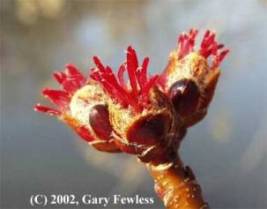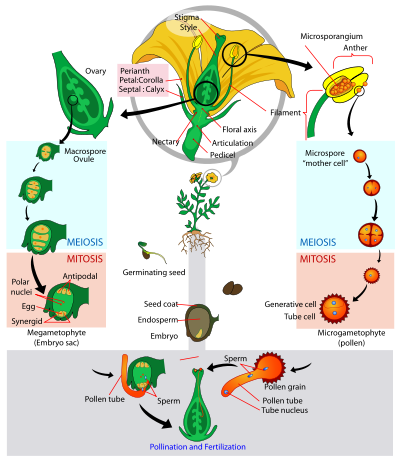As the World Goes Around
 Acer saccharinum
reproduction and life cycle is similar to most plants. Acer saccharinum
has an alternation of generation;
this means
that both the haploid (1n) and diploid (2n) stages are multicellular.
As a heterosporous plants, they can be found in both monoecious
and dioecious forms. This means that the male and female
reproductive parts are sometimes found on the same plant,
but can also be found on two different plants. If they are
found on the same plant, the ovulates (female) are found on
a different section of the tree than the pollen (male). This
reduces the chance of self fertilization.
Acer saccharinum
reproduction and life cycle is similar to most plants. Acer saccharinum
has an alternation of generation;
this means
that both the haploid (1n) and diploid (2n) stages are multicellular.
As a heterosporous plants, they can be found in both monoecious
and dioecious forms. This means that the male and female
reproductive parts are sometimes found on the same plant,
but can also be found on two different plants. If they are
found on the same plant, the ovulates (female) are found on
a different section of the tree than the pollen (male). This
reduces the chance of self fertilization.
The youngest that an Acer saccharinum can begin to produce seeds is
at
age eleven. Unlike most maples,
 Acer saccharinum goes
through meiosis in the fall to produce its reproductive
cells. This allows it to be one of the first trees to bloom
in spring, and gives the tree an advantage in pollination.
Birds and insects help to pollinate the flowers. Once
pollinated, a fruit begins to rapidly form. In less
than a day, a pollinated flower starts to
swell. The fruit
is matured within three weeks, and turns from a greenish red color to a yellowish brown. From April to June, the fruits
continue to ripen. Once the fruit ripens the keys
(as described in morphology) get carried by the wind. The best
soil for one of these seeds to grow in is moist, with a
large amount of minerals and organic matter. If conditions
are right, seeds will germinate immediately.
Acer saccharinum goes
through meiosis in the fall to produce its reproductive
cells. This allows it to be one of the first trees to bloom
in spring, and gives the tree an advantage in pollination.
Birds and insects help to pollinate the flowers. Once
pollinated, a fruit begins to rapidly form. In less
than a day, a pollinated flower starts to
swell. The fruit
is matured within three weeks, and turns from a greenish red color to a yellowish brown. From April to June, the fruits
continue to ripen. Once the fruit ripens the keys
(as described in morphology) get carried by the wind. The best
soil for one of these seeds to grow in is moist, with a
large amount of minerals and organic matter. If conditions
are right, seeds will germinate immediately.
Continue on and learn how Acer saccharinum absorbs
nutrients.